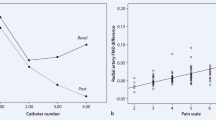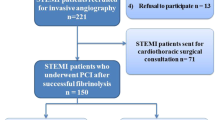Abstract
Objective:
Restenosis after percutaneous angioplasty of peripheral arteries is still an unsolved matter. Previous studies reported an association between flow-mediated dilatation (FMD), a marker of endothelial dysfunction, and restenosis after coronary angioplasty. This study evaluates the influence of FMD and brachial intima-media thickness (B-IMT) on restenosis after angioplasty of peripheral arteries.
Methods:
One hundred and eighty-four patients (124 male) with claudication related to peripheral arterial disease participated in this trial. FMD and B-IMT were assessed before endovascular revascularisation. In a 12-month follow-up duplex ultrasound examinations were performed to detect restenosis. Finally 128 patients (91male, 37 female) were eligible for statistical analysis.
Results:
Restenosis was found in 54 patients (42.2%). Mean FMD was 3.53 ± 3.56%, with no difference between the patients with restenosis (3.55 ± 3.64%) and those without (3.52 ± 3.48%; p = 0.716). B-IMT had a mean value of 0.326 ± 0.134 mm. B-IMT significantly differed between the patients with restenosis (0.326 ± 0.134 mm) and those without (0.256 ± 0.133 mm; p = 0.007). We confirmed that a B-IMT over 0.21 mm was an independent risk factor for restenosis [OR 2.9 (1.3–6.3)].
Conclusion:
Endothelial dysfunction is not associated with restenosis. Conversely patients with enlarged B-IMT are at risk of restenosis after angioplasty of peripheral arteries.

Similar content being viewed by others
References
Vane JR, Anggard EE, Botting RM (1990) Regulatory functions of the vascular endothelium. N Engl J Med 323:27–36
Insull W Jr (2009) The pathology of atherosclerosis: plaque development and plaque responses to medical treatment. Am J Med 122(1 Suppl):S3–S14
Celermajer DS, Sorensen KE, Gooch VM et al (1992) Non-invasive detection of early endothelial dysfunction in children and adults at risk of atherosclerosis. Lancet 340:1430–1432
Celermajer DS, Sorensen KE, Bull C et al (1994) Endothelium-dependent dilatation in the systemic arteries of asymptomatic subjects relates to coronary risk factors and their interaction. J Am Coll Cardiol 24:1468–1474
Brevetti G, Silvastro A, Schiano V, Chiarello M (2003) Endothelial dysfunction and cardiovascular risk prediction in peripheral artery disease: additive value of flow-mediated dilatation to ankle-brachial pressure index. Circulation 108:2093–2098
Anderson TJ, Uehata A, Gerhard MD, Meredith IT, Knab S, Delagrange D, Lieberman EH, Ganz P, Creager MA, Yeung AC (1995) Close relation of endothelial function in the human coronary and peripheral circulations. J Am Coll Cardiol 26:1235–1241
Pignolli P, Tremoli E, Poli A, Oreste P, Paoletti R (1986) Intima plus media thickness of the arterial wall: a direct measurement with ultrasound imaging. Circulation 74:1399–1406
Halcox JP, Donald AE, Ellins E, Witte DR, Shipley MJ, Brunner EJ, Marmot MG, Deanfield JE (2009) Endothelial function predicts progression of carotid intima-media thickness. Circulation 24(119):1005–1012
O’Leary DH, Polak JF, Kronmal RA, Manolio TA, Burke GL, Wolfson SK Jr (1999) Carotid-artery intima and media thickness as a risk factor for myocardial infarction and stroke in older adults. Cardiovascular Health Study Collaborative Research Group. N Engl J Med 340:14–22
Agewall S, Henareh L, Jogestrand T (2005) Intima-media complex of both the brachial artery and the common carotid artery are associated with left ventricular hypertrophy in patients with previous myocardial infarction. J Hypertens 23:119–125
Lind L, Andersson J, Rönn M, Gustavsson T, Holdfelt P, Hulthe J, Elmgren A, Zilmer K, Zilmer M (2008) Brachial artery intima-media thickness and echogenicity in relation to lipids and markers of oxidative stress in elderly subjects:–the Prospective Investigation of the Vasculature in Uppsala Seniors (PIVUS) Study. Lipids 43:133–141
Kitta Y, Nakamura T, Kodama Y, Takano H, Umetani K, Fujioka D, Saito Y, Kawabata K, Obata JE, Ichigi Y, Mende A, Kugiyama K (2005) Endothelial vasomotor dysfunction in the brachial artery is associated with late in-stent coronary restenosis. J Am Coll Cardiol 16(46):648–655
Akcakoyun M, Kargin R, Tanalp AC, Pala S, Ozveren O, Akcay M, Barutcu I, Kirma C (2008) Predictive value of noninvasively determined endothelial dysfunction for long-term cardiovascular events and restenosis in patients undergoing coronary stent implantation: a prospective study. Coron Artery Dis 19:337–343
Patti G, Pasceri V, Melfi R, Goffredo C, Chello M, D'Ambrosio A, Montesanti R, Di Sciascio G (2005) Impaired flow-mediated dilation and risk of restenosis in patients undergoing coronary stent implantation. Circulation 111:70–75
Wu TC, Chen YH, Chen JW, Chen LC, Lin SJ, Ding PY, Wang SP, Chang MS (2000) Impaired forearm reactive hyperemia is related to late restenosis after coronary stenting. Am J Cardiol 85:1071–1076
Corrado E, Camarda P, Coppola G, Muratori I, Ciaramitaro G, Farinella M, Novo G, Rotolo A, Andolina G, Cospite V, Evola S, Assennato P, Hoffmann E, Novo S (2009) Prognostic role of endothelial dysfunction and carotid intima-media thickness in patients undergoing coronary stent implantation. Int Angiol 28:12–19
Corretti MC, Anderson TJ, Benjamin EJ, Celermajer D, Charbonneau F, Creager MA, Deanfield J, Drexler H, Gerhard-Herman M, Herrington D, Vallance P, Vita J, Vogel R (2002) International Brachial Artery Reactivity Task Force. Guidelines for the ultrasound assessment of endothelial-dependent flow-mediated vasodilation of the brachial artery: a report of the International Brachial Artery Reactivity Task Force. J Am Coll Cardiol 39:257–265
Sorensen KE, Celermajer DS, Spiegelhalter DJ, Georgakopoulos D, Robinson J, Thomas O, Deanfield JE (1995) Non-invasive measurement of human endothelium dependent arterial responses: accuracy and reproducibility. Br Heart J 74:247–253
Ducharme A, Dupuis J, McNicoll S, Harel F, Tardif JC (1999) Comparison of nitroglycerin lingual spray and sublingual tablet on time of onset and duration of brachial artery vasodilation in normal subjects. Am J Cardiol 84(952–4):A8
Kervancioglu S, Davutoglu V, Ozkur A, Sezen Y, Kervancioglu R, Bayram MM (2004) Carotid and brachial intima-media thickness, arterial diameter and resistivity indices in aortic regurgitation. Acta Radiol 45:815–818
White CJ, Gray WA (2007) Endovascular therapies for peripheral arterial disease: an evidence-based review. Circulation 116:2203–2215
Dina JP, Feres T, Paiva AC, Paiva TB (2004) Role of membrane potential and expression of endothelial factors in restenosis after angioplasty in SHR. Hypertension 43:131–135
Wilson S, Gelfand D, Jimenez GI (2006) Comparison of the results of percutaneous transluminal angioplasty and stenting with medical treatment for claudicants who have superficial femoral artery occlusive disease. Vascular 14:81–87
Kamiya C, Sakamoto S, Tamori Y, Yoshimuta T, Higashi M, Tanaka R, Akutsu K, Takeshita S (2008) Long-term outcome after percutaneous peripheral intervention vs medical treatment for patients with superficial femoral artery occlusive disease. Circ J 72:734–739
Ferns GAA, Avades TY (2000) The mechanisms of coronary restenosis: insights from experimental models. Int J Exp Path 81:63–88
Le Tourneau T, Van Belle E, Corseaux D, Vallet B, Lebuffe G, Dupuis B, Lablanche JM, McFadden E, Bauters C, Bertrand ME (1999) Role of nitric oxide in restenosis after experimental balloon angioplasty in the hypercholesterolemic rabbit: effects on neointimal hyperplasia and vascular remodeling. J Am Coll Cardiol 33:876–882
Widlansky ME, Gocke N, Keaney JF (2003) The clinical implications of endothelial dysfunction. J Am Coll Cardiol 42:1149–1160
Anderson TJ, Gerhard MD, Meredith IT, Charbonneau F, Delagrange D, Creager MA, Selwyn AP, Ganz P, Anderson TJ, Gerhard MD, Meredith IT, Charbonneau F, Delagrange D, Creager MA, Selwyn AP, Ganz P (1995) Systemic nature of endothelial dysfunction in atherosclerosis. Am J Cardiol 75:71B–74B
Lafont A, Durand E, Samuel JL, Besse B, Addad F, Lévy BI, Desnos M, Guérot C, Boulanger CM (1999) Endothelial dysfunction and collagen accumulation: two independent factors for restenosis and constrictive remodeling after experimental angioplasty. Circulation 100:1109–1115
Tyagi SC, Meyer L, Schmaltz RA, Reddy HK, Voelker DJ (1995) Proteinases and restenosis in the human coronary artery: extracellular matrix production exceeds the expression of proteolytic activity. Atherosclerosis 116:43–57
Szmigielski C, Raczkowska M, Styczynski G, Pruszczyk P, Gaciong Z (2006) Metabolism of collagen is altered in hypertensives with increased intima media thickness. Blood Press 15:157–163
De Luca G, Suryapranata H, Gregorio G, Lange H, Chiariello M (2005) Homocysteine and its effects on in-stent restenosis. Circulation 112:e307–e311
Hansrani M, Oates C, Stansby G (2006) A prospective patient observational study of the role of hyperhomocysteinemia in restenosis in patients undergoing infrainguinal angioplasty or bypass procedures. Int Angiol 25:378–384
Baril DT, Marone LK, Kim J, Go MR, Chaer RA, Rhee RY (2008) Outcomes of endovascular interventions for TASC II B and C femoropopliteal lesions. J Vasc Surg 48:627–633
Acknowledgements
We would like to thank Mag. G. Dimsity for her assistance in performing the duplex scans in this trial.
Author information
Authors and Affiliations
Corresponding author
Rights and permissions
About this article
Cite this article
Hafner, F., Seinost, G., Gary, T. et al. Are flow-mediated vasodilatation and intima-media thickness of the brachial artery associated with restenosis after endovascular treatment of peripheral arterial occlusive disease?. Eur Radiol 20, 2533–2540 (2010). https://doi.org/10.1007/s00330-010-1801-z
Received:
Revised:
Accepted:
Published:
Issue Date:
DOI: https://doi.org/10.1007/s00330-010-1801-z




